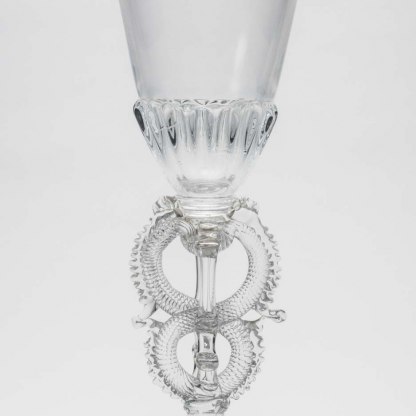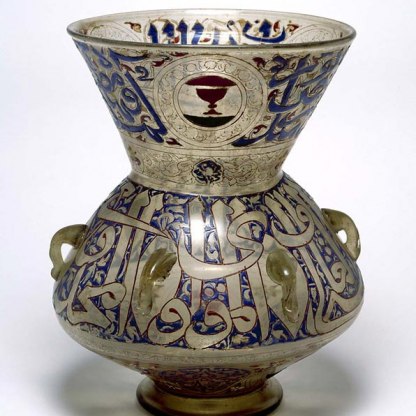Goblet

This goblet is one of the earliest securely dated examples of English glass. The year 1578 is engraved within a panel, surrounded by incised foliage. In another panel the letters AT and RT are intertwined – the initials of the otherwise anonymous couple whose marriage the glass was made to commemorate. A unicorn, two hounds and a stag run in a frieze around the rim.
The distinctive decoration allows us to recognize the goblet as a rare survival from the glasshouse of Jacopo Verzelini – although, paradoxically, the diamond-point engraving was the only aspect of the production that did not take place in the glasshouse itself. This was probably done by Anthony de Lysle, a Frenchman living in London.
Jacopo Verzelini had been born in Venice where the finest glass in Europe had been produced since the thirteenth century. Around 1500 Venetian glassmakers had developed cristallo glass which was clear, colourless and sparkled like crystal. This was highly prized throughout Europe and the Near East.
Verzelini arrived in London in 1571 and joined the factory of Jean Carré at the Hall of the Crutched Friars in the City of London. The following year, after Carré’s death, he took charge of the factory, and in 1574 Elizabeth I granted him exclusive rights for twenty-one years to produce 'Venetian' glass in England. Imports from Italy were forbidden, a ban that lasted until 1623 and which made Verzelini unpopular with London's tradesman.
This monopoly was strictly enforced: in 1581 a rival furnace was ordered to be demolished. But after Verzelini’s retirement in 1592, the patent for cristallo production was given to Sir Jerome Bowes, and Verzelini’s sons were both imprisoned for infringement of this man’s rights.
The popularity of crystalline glassware in Verzelini’s day is attested to in William Harrison’s A Description of England, written in 1586:
It is a world to see in these our days, wherein gold and silver most aboundeth, how that our gentility, as loathing those metals, do now generally choose rather the Venice glasses, both for our wine and beer ... and as this is seen in the gentility, so in the wealthy communalty the like desire of glass is not neglected.
Themes and periods
Data from our collections database
Dark soda glass, blown, and diamond point engraved. Deep-sided rounded bowl; hollow ribbed knop; circular blown foot rising up in the middle. The bowl is decorated with a frieze of hounds, a stag and a unicorn, and decorated with three panels containing respectively the initials 'AT' and 'RT' and the date '1578' within a frieze of foliage. The high foot is engraved with a foliate design.
Sir Hugh Dawson, Bart. from whom purchased through Delomosne & Sons, London
Legal notes
Purchased with the Beves, Marlay, and Glass Duplicates funds and with grant-in-aid from the Victoria and Albert Museum
Acquisition and important dates
- Method of acquisition: Bought
- Dates: 1967-04-27
Dating
English glass technology in the sixteenth century was less advanced than on the Continent, and luxury drinking vessels of colourless glass known as cristallo were imported from Venice. Demand outstripped supply, and in 1567 Jean Carré from Antwerp set up a glasshouse in London to produce Venetian-style glass. By 1571 he had been joined by Giacomo Verzelini, a Venetian, who had worked in Antwerp for many years. On Carré's death in 1572, Verzelini took over the running of the glasshouse, and in 1574 was granted a patent giving him the sole right to make and sell Venetian-style glass for 21 years. Two year later he was granted denization, and remained in England for the rest of his life. This goblet is one of nine attributed to Verzelini's glasshouse on the basis of their diamond-point engraved decoration, which incorporates dates between 1577 and 1586. The deep bowl is engraved with a stag, a unicorn, and hounds, with cartouches below enclosing the owners' initials RT and AT entwined by lover's knots, and the date 1578. This was probably the work of Anthony de Lysle, a Frenchman recorded in London in 1583 as a 'graver in puter and glass'. Made in the glasshouse at the Crutched Friars, London.
- 16th Century, Late
- Elizabeth I
- Production date: AD 1578 : dated. The glass might be slightly earlier than the engraving
Maker(s)
- Verzelini, Giacomo Glassmaker
- Probably de Lysle, Anthony Engraver
Note
English glass technology in the sixteenth century was less advanced than on the Continent, and luxury drinking vessels of colourless glass known as cristallo were imported from Venice. Demand outstripped supply, and in 1567 Jean Carré from Antwerp set up a glasshouse in London to produce Venetian-style glass. By 1571 he had been joined by Giacomo Verzelini, a Venetian, who had worked in Antwerp for many years. On Carré's death in 1572, Verzelini took over the running of the glasshouse, and in 1574 was granted a patent giving him the sole right to make and sell Venetian-style glass for 21 years. Two year later he was granted denization, and remained in England for the rest of his life. This goblet is one of nine attributed to Verzelini's glasshouse on the basis of their diamond-point engraved decoration, which incorporates dates between 1577 and 1586. The deep bowl is engraved with a stag, a unicorn, and hounds, with cartouches below enclosing the owners' initials RT and AT entwined by lover's knots, and the date 1578. This was probably the work of Anthony de Lysle, a Frenchman recorded in London in 1583 as a 'graver in puter and glass'. Made in the glasshouse at the Crutched Friars, London.
Place(s) associated
- London
Materials used in production
Read more about this recordStories, Contexts and Themes
Other highlight objects you might like
Suggested Curating Cambridge products
Sign up to our emails
Be the first to hear about our news, exhibitions, events and more…







